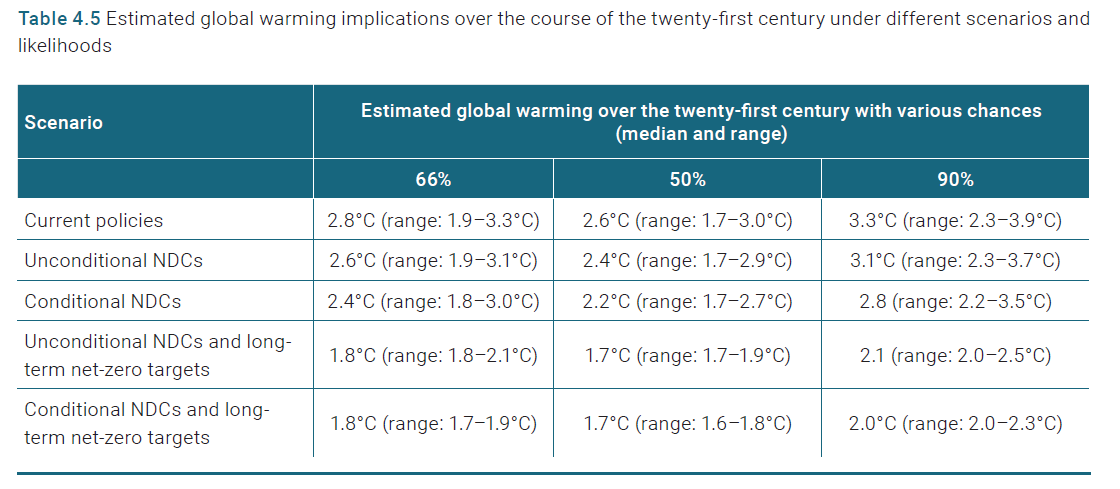
The latest #EmissionsGap report is out, but don't forget the uncertainty on 2100 temperature estimates.
Current policies lead to a median warming (50%) across the median of post-2030 scenario assumptions of 2.6°C with a range of 1.7°C to 3.0°C.
unep.org/resources/emis…
🧵
Current policies lead to a median warming (50%) across the median of post-2030 scenario assumptions of 2.6°C with a range of 1.7°C to 3.0°C.
unep.org/resources/emis…
🧵

"This range reflects the uncertainty due to extrapolation of GHG emissions after the year 2030 and is given for the central estimate of 2030 emissions implied by current policies, NDCs and/or other pledges." (from EGR2021)
Geophysical uncertainties are on top of this!
2/
Geophysical uncertainties are on top of this!
2/
"Geophysical uncertainties in the climate response are reflected by the estimates for different warming percentiles (50 per cent, 66 per cent and 90 per cent)." (from EGR2021)
3/
3/
Current Policies:
* Median climate outcome: 2.6°C (range: 1.7–3.0°C)
* 66% climate outcome: 2.8°C (range: 1.9–3.3°C)
* 90% climate outcome: 3.3°C (range: 2.3–3.9°C)
UNEP reports the 66% climate outcomes, which assumes the climate is worse that what scientists expect (50%).
4/
* Median climate outcome: 2.6°C (range: 1.7–3.0°C)
* 66% climate outcome: 2.8°C (range: 1.9–3.3°C)
* 90% climate outcome: 3.3°C (range: 2.3–3.9°C)
UNEP reports the 66% climate outcomes, which assumes the climate is worse that what scientists expect (50%).
4/

I think this is incredibly confusing.
Journalists will innocently report "...the study finds that with the current policies in place, the world will warm by around 2.8°C this century." @MattMcGrathBBC
bbc.com/news/science-e…
This is the 66% chance, but is worded as if 50%.
5/
Journalists will innocently report "...the study finds that with the current policies in place, the world will warm by around 2.8°C this century." @MattMcGrathBBC
bbc.com/news/science-e…
This is the 66% chance, but is worded as if 50%.
5/
The UNEP press release does mention this, unep.org/news-and-stori…, but I think very few would understand the nuance here.
It also makes it confusing, as when people compare IEA (50%) with UNEP (66%), they are not comparing like-with-like.
6/
It also makes it confusing, as when people compare IEA (50%) with UNEP (66%), they are not comparing like-with-like.
6/

Moving beyond my hobby horse, the key point is that there is a HUGE range due to scenario uncertainty!
Current Policies (50%): 2.6°C (range: 1.7–3.0°C).
We need to talk about this...
7/
Current Policies (50%): 2.6°C (range: 1.7–3.0°C).
We need to talk about this...
7/
The median scenario outcome (dark blue), presumably, has declining emissions under current policies. Perhaps.
We need to explore this much further:
* What conditions lead to 1.7°C under current policies?
* What conditions lead to 3.0°C under current policies?
8/
We need to explore this much further:
* What conditions lead to 1.7°C under current policies?
* What conditions lead to 3.0°C under current policies?
8/

My colleague @idasogn led an important paper @ParisReinforce on this issue.
Despite harmonising most things, "emissions are more sensitive to the choice of integrated assessment model than to the assumed mitigation effort"
rdcu.be/cBOBr
9/
Despite harmonising most things, "emissions are more sensitive to the choice of integrated assessment model than to the assumed mitigation effort"
rdcu.be/cBOBr
9/

Just as we need to shift away from the 1.5°C threshold obsession, we need to shift away from the obsession with very precise estimates of 2100 warming levels that are underpinned by so many assumptions, scenario & climate.
10/10
10/10
• • •
Missing some Tweet in this thread? You can try to
force a refresh



















